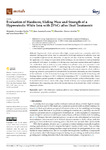Mostrar o rexistro simple do ítem
Evaluation of Hardness, Sliding Wear and Strength of a Hypoeutectic White Iron with 25%Cr after Heat Treatments
| dc.contributor.author | González-Pociño, Alejandro | |
| dc.contributor.author | Asensio-Lozano, Juan | |
| dc.contributor.author | Álvarez-Antolín, J. F. | |
| dc.contributor.author | García-Diez, Ana | |
| dc.date.accessioned | 2021-09-21T17:03:19Z | |
| dc.date.available | 2021-09-21T17:03:19Z | |
| dc.date.issued | 2021-06 | |
| dc.identifier.citation | González-Pociño, A.; Asensio-Lozano, J.; Álvarez-Antolín, F.; García-Diez, A. Evaluation of Hardness, Sliding Wear and Strength of a Hypoeutectic White Iron with 25%Cr after Heat Treatments. Metals 2021, 11, 947. https://doi.org/10.3390/met11060947 | |
| dc.identifier.issn | 2075-4701 | |
| dc.identifier.uri | http://hdl.handle.net/2183/28494 | |
| dc.description.abstract | [Abstract] Hypoeutectic white cast irons with a high chrome content are commonly used in the industrial mining sector where there is a demand for both high resistance to adhesive wear and an acceptable toughness for the absorption of impacts and falls of diverse materials. Through the application of a design of experiment (DoE) technique, factors related to thermal treatment are analyzed with respect to resistance to sliding wear, maximum rupture stress and toughness. The results show that, in order to increase resistance to adhesive wear, it is convenient to use destabilization temperatures of 1050 ◦C and tempering of two hours at 400 ◦C. This foments a very hard martensite and a high proportion of highly alloyed retained austenite, which, with low tempering, achieves a precipitation of carbides from this austenite with hardly any loss of hardness of the martensite. In order to increase the energy which this material is capable of absorbing until breakage, furnace cooling set at 150 ◦C followed by tempering at 550 ◦C would be favorable. Slower cooling implies a greater quantity of conditioned retained austenite, so that, following this, it may be transformed into lower bainite with a high density of finely dispersed precipitated carbides. Furthermore, this tempering also allows the transformation of martensite into ferrite with finely dispersed carbides. | es_ES |
| dc.language.iso | eng | es_ES |
| dc.publisher | MDPI | es_ES |
| dc.relation.uri | https://doi.org/10.3390/met11060947 | es_ES |
| dc.rights | Atribución 4.0 Internacional | es_ES |
| dc.rights.uri | http://creativecommons.org/licenses/by/4.0/ | * |
| dc.subject | Hierros blancos | es_ES |
| dc.subject | Minerales - Tratamiento térmico | es_ES |
| dc.subject | High Cr–Mo white irons | |
| dc.subject | Hardness | |
| dc.subject | Adhesive wear testing | |
| dc.subject | 3p-bend test | |
| dc.subject | Heat treatment | |
| dc.subject | Microstructure–properties correlation | |
| dc.title | Evaluation of Hardness, Sliding Wear and Strength of a Hypoeutectic White Iron with 25%Cr after Heat Treatments | es_ES |
| dc.type | info:eu-repo/semantics/article | es_ES |
| dc.rights.access | info:eu-repo/semantics/openAccess | es_ES |
| UDC.journalTitle | Metals | es_ES |
| UDC.volume | 11 | es_ES |
| UDC.issue | 6 | es_ES |
| dc.identifier.doi | 10.3390/met11060947 |
Ficheiros no ítem
Este ítem aparece na(s) seguinte(s) colección(s)
-
GI-CIM - Artigos [19]






